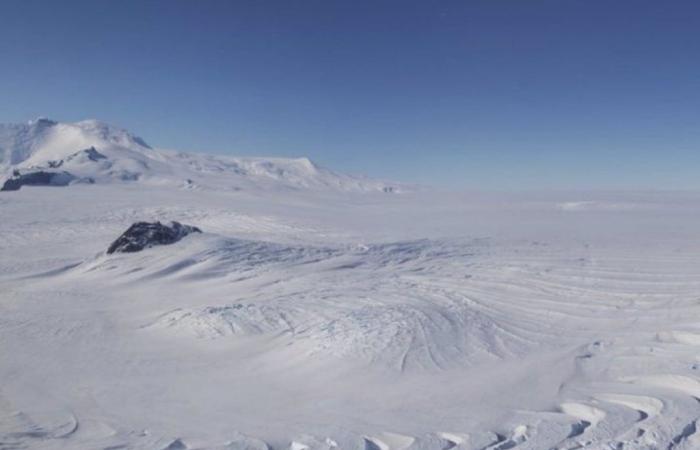MADRID, June 28 (EUROPA PRESS) –
The melted snow (soaked with water) constitutes more than half of all the meltwater of the Antarctic ice shelves in midsummer, but the models do not take this into account.
A team of researchers from the University of Cambridge has used artificial intelligence techniques to map the melting snow from Antarctica’s ice shelves and has discovered that 57% of all Antarctic meltwater is in the form of melted snowand the rest is found in surface ponds and lakes.
As the climate warms, more meltwater forms on the surface of ice shelves, the floating ice surrounding Antarctica that acts as a buttress against the ice of glaciers inland. The increased amount of meltwater can cause instability or collapse of ice shelves, which in turn causes sea level rise.
The researchers also found that melted snow and stagnant meltwater cause 2.8 times more meltwater formation than predicted by standard climate modelsas it absorbs more heat from the sun than ice or snow. The results, published in the journal Nature Geosciencecould have profound implications for ice shelf stability and sea level rise.
Each summer, as the climate warms, water accumulates on the surfaces of Antarctica’s floating ice shelves. Previous research has shown that shallow meltwater lakes can contribute to the fracturing and collapse of ice shelves, as the weight of the water can cause the ice to bend or break. However, the role of melted snow in the stability of ice shelves It is more difficult to determine.
“We can use satellite images to map meltwater lakes across much of Antarctica, but it’s difficult to map slush because it looks like other things, like cloud shadows, when viewed from a satellite,” he said. it’s a statement lead author Dr Rebecca Dell, from the Scott Polar Research Institute (SPRI) in Cambridge. “But using machine learning techniques, we can go beyond what the human eye can see and get a clearer picture of “how water-soaked snow could be affecting ice in Antarctica.”
Using optical data from NASA’s Landsat 8 satellite, the Cambridge researchers, in collaboration with researchers at the University of Colorado at Boulder and Delft University of Technology, trained a machine learning model to obtain monthly records of melting snow and lakes. meltwater on 57 Antarctic ice shelves between 2013 and 2021.
“Machine learning allows us to use more information from the satellite because it can work with more wavelengths of light than the human eye can see,” Dell said. “This allows us to determine what is and isn’t snowmelt, and we can then train the machine learning model to quickly identify it across the continent.”
“We are interested in knowing how much such snow there is during the Antarctic summer and how it has changed over time,” said co-author Professor Ian Willis, also from SPRI.
Using their machine learning model, the researchers found that in January, at the height of the Antarctic summer, more than half (57%) of all meltwater from Antarctic ice shelves is in the form of water-soaked snow , and the remaining 43% in meltwater lakes.
“This water-soaked snow has never been mapped on a large scale across all of Antarctica’s large ice shelves, so more than half of all surface meltwater has been ignored until now,” Dell said. “This is potentially significant for the hydrofracturing process, where the weight of meltwater can create or enlarge fractures in the ice.”
Meltwater affects the stability of the floating ice shelves that line the Antarctic coast. As the climate warms and melt rates increase in Antarctica, meltwater (either in the form of lakes or melted snow) can enter cracks in the ice, causing them to enlarge. This can cause fractures in the ice shelf and could lead to the collapse of vulnerable ice shelves, which in turn would allow ice from inland glaciers to spill into the ocean and contribute to sea level rise.
“Because snowmelt is more solid than meltwater, it won’t cause hydrofractures in the same way that lake water does, but it’s definitely something we need to take into account when trying to predict how or if ice shelves will collapse,” Willis said.
In addition to the potential implications of melting snow on hydrofracturing, it also has a large effect on melting rates. Because slush and lakes are less white than snow or ice, they absorb more heat from the sun, leading to more melting. This additional melting is not currently accounted for in climate models, which which may lead to underestimations of ice sheet melt projections and ice shelf stability.
DOES NOT COUNT IN CLIMATE MODELS
“I was surprised that this meltwater was so under-represented in climate models,” Dell said. “Our job as scientists is to reduce uncertainty, so we always want to improve our models to be as accurate as possible.”
“In the future, places in Antarctica that currently have no water or snowmelt are likely to begin to change,” Willis said. “As the climate continues to warm, more melting will occur, which could have implications for ice stability and sea level rise.”






